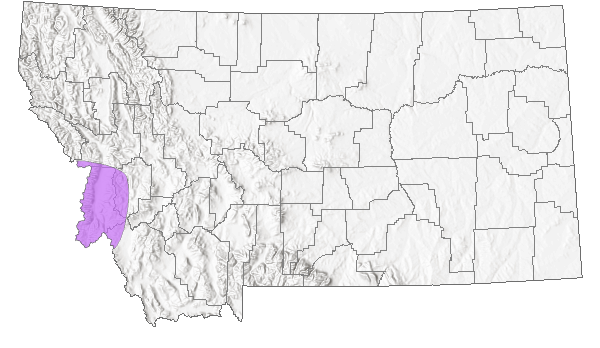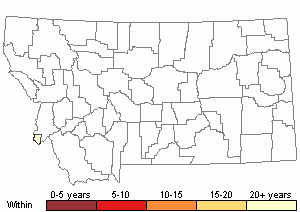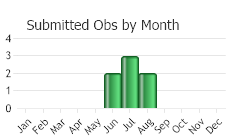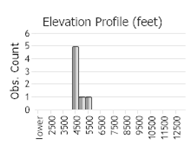View in other NatureServe Network Field Guides
NatureServe
Montana
Utah
Wyoming
Idaho
Wisconsin
British Columbia
South Carolina
Yukon
California
New York
Idaho Goldenweed - Tonestus aberrans
Other Names:
Haplopappus aberrans, Triniteurybia aberrans, Eurybia aberrans
State Rank Reason (see State Rank above)
Known from two moderate-sized occurrences and two smaller occurrences on the Bitterroot National Forest and adjacent private land. One population occurs adjacent to a road, where construction may have impacted the population. No negative impacts to the populations are currently known to be occurring. However, populations are susceptible to potential impacts associated with roads and rock climbing.
- Details on Status Ranking and Review
Population Size
Score3 - Vey Small: Generally <2,000 individuals.
Range Extent
Score3 - Local Endemic or Very Small Montana Range: Generally restricted to an area <10,000 sq. miles (equivalent to the combined area of Phillips and Valley Counties) or <6 Sub-basins (4th code watersheds) Range-wide OR limited to one Sub-basin in Montana
Area of Occupancy
Score3 - Very Low: Generally occurring in 3 or fewer Subwatersheds (6th Code HUC’s).
Environmental Specificity
Score1 - Moderate: Species is restricted to a specific habitat that is more widely distributed or to several restricted habitats and is typically dependent upon relatively unaltered, good-quality habitat (C Values of 5-7).
Trends
Score1 - Minor Declines: Species has experienced declines of 10-30% in population size, range extent and/or occupied area in the recent past (approximately 30 years).
CommentTrend data are unavailable, though it appears that minor declines may have occurred from activities at the sites.
Threats
Score2 - High: 31-70% of the populations are being negatively impacted or are likely to be impacted by one or more activities or agents, which are expected to result in decreased populations and/or habitat quality and/or quantity.
CommentThreats from road construction/maintenance and rock climbing activity have been identified though the magnitude or imminence of these potential threats are uncertain.
Intrinsic Vulnerability
Score1-2 - Moderate to High Vulnerability.
Raw Conservation Status Score
Score
14 to 15 total points scored out of a possible 19.
General Description
Idaho Golden-weed is a perennial herb with several slender stems that are 5-25 cm high and which arise from a branched rootcrown. The basal leaves are up to 10 cm long and have sharply toothed margins, while the upper leaves are sessile and narrower. Foliage is glandular-hairy. 1 to a few short-stalked flower heads are borne in the axils of the uppermost reduced leaves, or bracts. Each head has 3-4 series of narrow, green-tipped, overlapping, glandular involucral bracts that are up to 1 cm high. There are 25-50 reddish-yellow disk flowers that are 6-8 mm long, and ray flowers are lacking. The elongate achenes are topped by numerous, dingy white bristles, which form a pappus of unequal length.
Lesica (2012) treats this as Triniteurybia aberrans (A. Nelson) Brouillet, Urbatsch & R.P. Roberts.
Phenology
Flowering July-August.
Diagnostic Characteristics
Pyrrocoma carthamoides also has sharply toothed leaves and lacks ray flowers, but its involucral bracts are 15-30 mm high.
Species Range
Montana Range
Range Descriptions

 Native
Native
Range Comments
Central Idaho and southwestern Montana. Regional endemic, known from one mountain range.
Observations in Montana Natural Heritage Program Database
Number of Observations: 8
(Click on the following maps and charts to see full sized version)
Map Help and Descriptions
Relative Density

Recency



 (Observations spanning multiple months or years are excluded from time charts)
(Observations spanning multiple months or years are excluded from time charts)
Habitat
Crevices of granite cliffs and outcrops in dry coniferous forests of the montane zone.
National Vegetation Classification System Groups Associated with this Species
Sparse and Barren
Sparse and Barren
Stewardship Responsibility
References
- Literature Cited AboveLegend:
 View Online Publication
View Online Publication Lesica, P., M.T. Lavin, and P.F. Stickney. 2012. Manual of Montana Vascular Plants. Fort Worth, TX: BRIT Press. viii + 771 p.
Lesica, P., M.T. Lavin, and P.F. Stickney. 2012. Manual of Montana Vascular Plants. Fort Worth, TX: BRIT Press. viii + 771 p.
- Additional ReferencesLegend:
 View Online Publication
View Online Publication
Do you know of a citation we're missing? Hall, H.M. 1928. The genus Haplopappus, a phylogenetic study in the compositae. Carnegie Institution of Washington Publication No. 389, Washington D.C. 391 pp.
Hall, H.M. 1928. The genus Haplopappus, a phylogenetic study in the compositae. Carnegie Institution of Washington Publication No. 389, Washington D.C. 391 pp. Lesica, P., M.T. Lavin, and P.F. Stickney. 2022. Manual of Montana Vascular Plants, Second Edition. Fort Worth, TX: BRIT Press. viii + 779 p.
Lesica, P., M.T. Lavin, and P.F. Stickney. 2022. Manual of Montana Vascular Plants, Second Edition. Fort Worth, TX: BRIT Press. viii + 779 p. Shelly, J. S. and M. Mantas. 1993. Noteworthy collections, Montana. Madrono 40:271-273.
Shelly, J. S. and M. Mantas. 1993. Noteworthy collections, Montana. Madrono 40:271-273.
- Web Search Engines for Articles on "Idaho Goldenweed"





